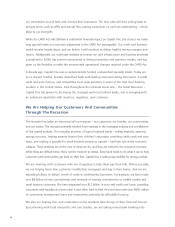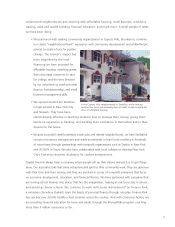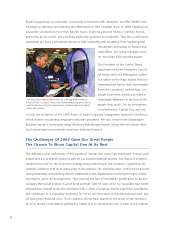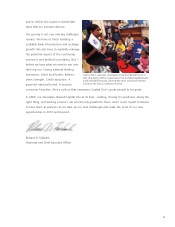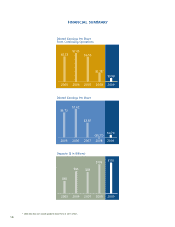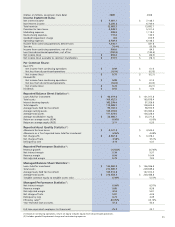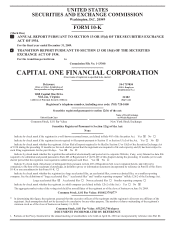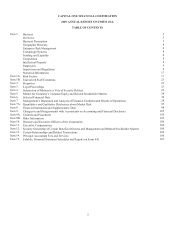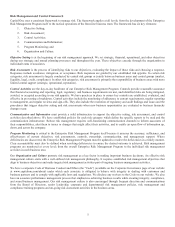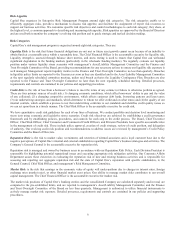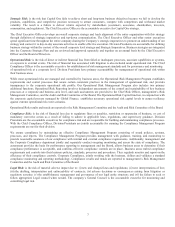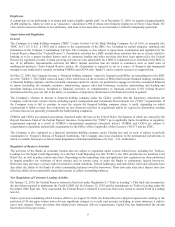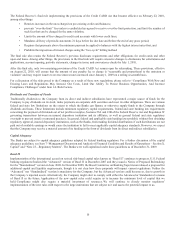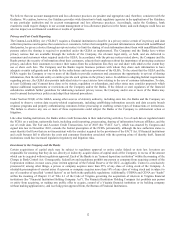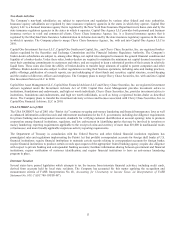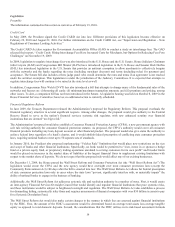Capital One 2009 Annual Report Download - page 17
Download and view the complete annual report
Please find page 17 of the 2009 Capital One annual report below. You can navigate through the pages in the report by either clicking on the pages listed below, or by using the keyword search tool below to find specific information within the annual report. 4
Geographic Diversity
Our consumer loan portfolios, including credit cards, are diversified across the United States with modest concentration in New York,
New Jersey, Louisiana, and Texas. We also have credit card loans in the U.K. and Canada. Our commercial loans are concentrated in
New York, New Jersey, Louisiana and Texas. See Item 7 “Management’s Discussion and Analysis of Financial Condition and results
of Operations – Loans Held for Investment”, “Management’s Discussion and Analysis of Financial Condition and results of
Operations – Credit Concentration” and “Note 24—Significant Concentration of Credit Risk” for further details.
Enterprise Risk Management
Capital One’s policy is to identify, assess, and mitigate risks that affect or have the potential to affect our business, to target financial
returns commensurate with the Company’s risk appetite, and to avoid excessive risk-taking. We follow three key principles related to
this policy.
1. Individual businesses take and manage risk in pursuit of strategic, financial, and other business objectives
2. Independent risk management organizations support individual businesses by providing risk management tools and
policies, and by aggregating risks; in some cases, risks are managed centrally
3. The Board of Directors and top management review our aggregate risk position and establish the risk appetite
Our approach is reflected in four critical risk management practices of particular importance in today’s environment.
First, we recognize liquidity risk as among the critical risks facing financial institutions today. We seek to mitigate this risk
strategically and tactically. From a strategic perspective, we have acquired and built deposit gathering businesses and significantly
reduced our loan to deposit ratio. From a tactical perspective, we have accumulated a very large liquidity reserve comprising cash,
high-quality, unencumbered securities, and committed collateralized credit lines and conduit facilities.
Second, we recognize that credit issues are a frequent cause of financial institution stress and that we are exposed to cyclical changes
in credit quality. Consequently, we try to ensure our credit portfolio is resilient to economic downturns. Our most important tool is
sound underwriting, using what we deem to be conservative assumptions. In unsecured consumer loan underwriting, we assume that
loans will be subject to an environment in which losses are significantly higher than those prevailing at the time of underwriting. In
commercial underwriting, we insist on strong cash flow, strong collateral, and strong covenants and guarantees. In addition to
conservative underwriting, we aggressively monitor our portfolio and aggressively collect or work out distressed loans.
Third, we recognize that reputational risk is of particular concern in today’s turbulent environment. Consequently, our CEO and
executive team manage both tactical and strategic reputation issues and build our relationships with the government, media, and other
constituencies to help strengthen the reputations of both Capital One and our industry. This includes taking public positions in support
of better consumer practices in our industry and, where possible, unilaterally implementing those practices in our business.
Finally, we recognize that maintaining appropriate capital levels is a concern in today’s environment. See Item 7 “Management’s
Discussion and Analysis of Financial Condition and results of Operations – Capital,” for further information regarding capital.
Risk Management Roles and Responsibilities
The Board of Directors is responsible for establishing Capital One’s overall risk framework; approving and overseeing execution of
the Enterprise Risk Management Policy and key risk category policies; establishing the Company’s risk appetite; and regularly
reviewing Capital One’s risk profile.
The Chief Risk Officer, who reports to the CEO, is responsible for overseeing Capital One’s risk management program and driving
appropriate action to resolve any weaknesses. The risk management program begins with a set of policies and risk appetites approved
by the Board that are implemented through a system of risk committees and senior executive risk stewards. The company has
established risk committees at both the corporate and divisional level to identify and manage risk. In addition, we have assigned a
senior executive expert to each of eight risk categories (the risk stewards). These executive risk stewards work with the Chief Risk
Officer and the risk committees to ensure that risks are identified and given appropriate priority and attention. The Chief Risk Officer
aggregates the results of these processes to assemble a view of the company’s risk profile. Both management and the Board regularly
review the risk profile.


